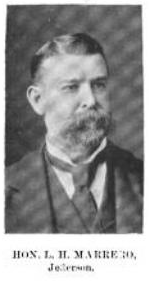Louis H. Marrero
| Louis H. Marrero | |
|---|---|
 Louis H. Marrero | |
| Personal details | |
| Born |
August 17, 1847 Adams County, Mississippi |
| Died |
1921 Unknown |
| Nationality | American |
| Political party | Democrat |
| Spouse(s) | Elodie |
| Profession | Soldier, politician, Chief of Police, Businessman, Banker and Landowner |
| Religion | Catholic |
Louis Herman Marrero (July 17, 1847 – 1921) was a prominent American soldier, politician, businessman, banker, chief of police, and landowner.[1] During his lifetime, he served in many political offices, such as governor of Saint Bernard Parish (1884–1896), Sheriff (1896), President of Jefferson Parish, Louisiana (1884–1916) and United States Senator for Louisiana (1892–1896). He also served as the President of the Jefferson Commercial & Savings bank (in Gretna, Louisiana), and president of the Marrero Land and Improvement Association, Ltd.
Biography
Louis H. Marrero was born on July 17, 1847 near Kingston, in Adams County, Mississippi. His father, Bastian A. Marrero, was born in St. Bernard Parish, Louisiana, while his mother, Anna Lydia Marrero, was born in Adams County, Mississippi.[2] He was the eldest of five siblings. His siblings were Alonso, F. William, Eugene C. and Frank G.[2] His paternal great-grandparents were Spanish settlers, Bartolomé Marrero and Josefa Sosa, who originated in the Canary Islands and arrived in Louisiana from Santa Cruz de Tenerife in October 15, 1778, with their daughters and other Canarian settlers.[3][4] Louis H. Marrero mainly studied at the Potter Private School and the preparatory department of the Centenary College of Louisiana at Jackson.
When he was 15 years old, he enlisted in Company C, 25th Louisiana Infantry, and fought at the Battle of Farmington as well as the Second Battle of Corinth. He also fought alongside Bragg's army in the state of Kentucky, in Nashville and Murfreesboro, Tennessee (where he was wounded) and in Jackson, Mississippi. On November 25, 1863, he was captured and imprisoned at Rock Island, Illinois. He remained there until March 1865, when he was taken to Richmond and put on probation.
Later, he was also a member of the Army of Tennessee and the Secession Convention. In 1861 (when the Secession War began), Marrero formed a military regiment. Although he was appointed colonel, he did not participate in the military. After the war ended, Louis H. Marrero was devoted to planting and marketing. Later, in 1867, he moved to St. Bernard Parish where he served as sheriff for many years. Since 1881, he continued this job in the Jefferson Parish.
He was an active member in the Democratic party, being elected to several charges: the Police Jury of Jefferson Parish (1883–1896), Governor of Saint Bernard Parish (1884–1896), member of the Louisiana Senate (1892–1896), member of the Lafourche Parish Levee Board (1892–1896), Sheriff (1896), and member of the Constitutional Convention of 1898.[2] He also had many other occupations,[2][5] most notably as president of the Jefferson Commercial & Savings bank,[2][5][6] in Gretna, Louisiana, and as president of the Marrero Land and Improvement Association, Ltd.[2][5][6]
During his administration in Jefferson Parish, he attracted companies to the region and founded stores devoted to the sale of agricultural products to benefit the local farmers.[7]
Marrero served as the President of the Jefferson Commercial & Savings bank since its founding. Simultaneously he also served as the President of the Marrero Land and Improvement Association.[2][6]
He died in 1921.
Personal life
In 1868, Louis H. Marrero married Elodie Marrero. They had three children: Leo A., William Felix, and Louis H. Jr. He was Catholic[2] and a wealthy landowner. In the late nineteenth century, he obtained a large plot of land, located near the Ames Plantation, and he leased or sold small land's plots to vegetable farmers.[7] He and his son, Leo A. Marrero, along with other relatives, founded the Marrero Land and Improvement Association, an organization that encompassed much of Westbank (particularly the Marrero and Harvey areas).[8]
Legacy
- The Marrero town and the Louis H Marrero Park, both in Jefferson Parish, were founded after him.[9]
- The Marrero Road (a road localized between Ames Boulevard and Barataria Boulevard) was founded after him. The Marrero Road was built at the principal land of Louis H. Marrero.[1]
References
- 1 2 Earl Higgins (2011). Metairie, Ames, High: The Streets of Jefferson Parish. Page 85.
- 1 2 3 4 5 6 7 8 Mike Miller (Apr. 1998). Louis H. Marrero: Adams County, MS., Louisiana.
- ↑ Miguel Rodríguez Díaz de Quintana. El origen de los Marreros canarios (in Spanish: The origin of the Canarian Marreros).
- ↑ Dr. Gilbert C. Din (August 1, 1999). The Canary Islanders in Louisiana. Louisiana State University Press.
- 1 2 3 Barkley Estates: About of BECA.
- 1 2 3 Times-Picayune Obituary. 02-27-1921, page 65
- 1 2 Betsy Swanson (Second edition: February, 2004). Historic Jefferson Parish: From Shore to Shore. Page 122.
- ↑ Paul F. Stahls (2009). Jefferson Parish: Rich Heritage Promising Future. Page 44.
- ↑ Mapcarta: Louis H Marrero Park Map - Louisiana - Mapcarta.